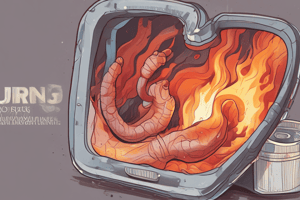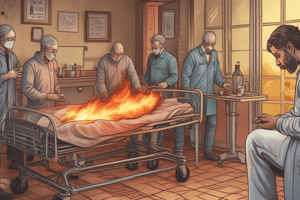Podcast
Questions and Answers
Which of the following is a characteristic of the inflammatory phase of dermal healing?
Which of the following is a characteristic of the inflammatory phase of dermal healing?
- Formation of scar tissue by fibroblasts
- Scars becoming more prominent over time
- Redness, edema, warmth, and pain (correct)
- Scar tissue remodeling lasting up to 2 years
Povidone-iodine solution is recommended for cleaning non-infected wounds.
Povidone-iodine solution is recommended for cleaning non-infected wounds.
False (B)
What type of scar may result from dermal healing, appearing more common in young women and those with dark skin?
What type of scar may result from dermal healing, appearing more common in young women and those with dark skin?
Keloid scar
In wound classification, a Stage II wound involves complete loss of the _____ and extends into the dermis.
In wound classification, a Stage II wound involves complete loss of the _____ and extends into the dermis.
Match each cleaning agent with its primary effective use:
Match each cleaning agent with its primary effective use:
Which of the following is a disadvantage of using acetic acid (vinegar) in wound care?
Which of the following is a disadvantage of using acetic acid (vinegar) in wound care?
Hydrogen peroxide is a selective debridement agent, making it ideal for use on all types of wounds.
Hydrogen peroxide is a selective debridement agent, making it ideal for use on all types of wounds.
What is the best antibacterial ointment for burns, according to the content provided?
What is the best antibacterial ointment for burns, according to the content provided?
During physical therapy intervention for impaired integumentary integrity, one should assist patients to avoid harsh _____, which can hinder healing.
During physical therapy intervention for impaired integumentary integrity, one should assist patients to avoid harsh _____, which can hinder healing.
Match each electrotherapeutic modality with its primary therapeutic effect:
Match each electrotherapeutic modality with its primary therapeutic effect:
What is the primary indication for using pulsed lavage during whirlpool therapy?
What is the primary indication for using pulsed lavage during whirlpool therapy?
Whirlpool therapy is appropriate for all types of wounds, including those with venous insufficiency and venous ulcers.
Whirlpool therapy is appropriate for all types of wounds, including those with venous insufficiency and venous ulcers.
What is the ultrasound setting used over the wound to accelerate skin repair?
What is the ultrasound setting used over the wound to accelerate skin repair?
_________ Compression assists in venous return and stimulates the release of cellular factors that could facilitate wound healing.
_________ Compression assists in venous return and stimulates the release of cellular factors that could facilitate wound healing.
Match the type of ultraviolet ray with its primary application in wound care:
Match the type of ultraviolet ray with its primary application in wound care:
According to the content, what is the purpose of using a negative pressure wound therapy?
According to the content, what is the purpose of using a negative pressure wound therapy?
When providing wound care, it is acceptable for healthcare practitioners to use the same handwashing techniques for patients with multiple infections.
When providing wound care, it is acceptable for healthcare practitioners to use the same handwashing techniques for patients with multiple infections.
What intervention is used to assist with wound healing d/t enhanced solubility of the oxygen in the blood?
What intervention is used to assist with wound healing d/t enhanced solubility of the oxygen in the blood?
Normal Saline is _____ % NaCI and is recommended for most ulcers, and has non-toxic effects in the wound.
Normal Saline is _____ % NaCI and is recommended for most ulcers, and has non-toxic effects in the wound.
Match each wound care dressing with its characteristics:
Match each wound care dressing with its characteristics:
Flashcards
Epidermal healing
Epidermal healing
Retention of viable cells that allows for epithelialization to occur.
Dermal healing
Dermal healing
Results in scar formation where injured tissue is replaced by connective tissue.
Inflammatory phase
Inflammatory phase
Characterized by redness, edema, warmth, pain and decreased range of motion, lasting 3-5 days.
Proliferative phase
Proliferative phase
Signup and view all the flashcards
Maturation phase
Maturation phase
Signup and view all the flashcards
Sterile Saline Formula
Sterile Saline Formula
Signup and view all the flashcards
Povidone-lodine (Betadine)
Povidone-lodine (Betadine)
Signup and view all the flashcards
Patient instructions
Patient instructions
Signup and view all the flashcards
Sound agent
Sound agent
Signup and view all the flashcards
Hydrotherapy
Hydrotherapy
Signup and view all the flashcards
Light agents
Light agents
Signup and view all the flashcards
Intermittent Pneumatic Compression
Intermittent Pneumatic Compression
Signup and view all the flashcards
Galvano
Galvano
Signup and view all the flashcards
Infrared Ray
Infrared Ray
Signup and view all the flashcards
Hyperbaric Oxygen Therapy
Hyperbaric Oxygen Therapy
Signup and view all the flashcards
Negative Pressure Wound Therapy
Negative Pressure Wound Therapy
Signup and view all the flashcards
Vacuum-assisted closure
Vacuum-assisted closure
Signup and view all the flashcards
Wound dressing
Wound dressing
Signup and view all the flashcards
Xenograft
Xenograft
Signup and view all the flashcards
Autograft
Autograft
Signup and view all the flashcards
Study Notes
- These notes are for the management of burns and integumentary integrity impairment
Factors Delaying Healing
- Intrinsic factors that hinders healing include age, medical conditions, and nutritional status
- Extrinsic factors that hinders healing include cytotoxic agents and drug-induced activity
Wound Healing
Epidermal Healing
- Retention of viable cells allows epithelialization so epithelial cells grow, proliferate, and migrate to close wound
- Protection of epithelial cells during healing is critical
- Loss of sebaceous glands dries and cracks the wound, making moisturizing creams important
Dermal Healing
- Dermal healing results in scar formation as injured tissue gets replaced by connective tissue
- Scars are initially red or purple then later turns white
Inflammatory Phase
- The first phase of dermal wound healing is characterized by redness, edema, warmth, pain, and decreased range of motion, lasting 3-5 days
Proliferative Phase
- The second phase of dermal wound healing is when fibroblasts form scar tissue in deeper tissues
- Wound contraction is characteristic and re-epithelialization may occur at the wound surface if viable cells remain
Maturation Phase
- Scar tissues remodels during the final maturation phase, lasting up to 2 years
- Hypertrophic scars and/or keloid scars may result
Pharmacological Interventions: Cleaning Agents
Sterile Saline / Normal Saline Formula
-
- 9 grams of non-iodized table salt is needed for every 100ml of distilled water
- Formila is used in hospitals, for non-infected wounds but is non-cytotoxic to cells
Povidone Lodine (Betadine Solution)
- Can be used as an initial or first cleansing agent whether the wound is infected or not
- It is indicated for infected wounds and is its most effective cleaning agent
- Disadvantage is that it is cytotoxic to granulation tissue
Sodium Hypochlorite (House Bleach)
- Indicated for infected wounds, and is the second most effective for infected wounds
Other Cleaning Agents
Acetic Acid (Vinegar)
- Indicated and most effective as the third choice for infected wounds
- Inhibits bacteria from spreading/proliferating
- Acetic acid can be used to manage contamination with Pseudomonas aeruginosa
- Is cytotoxic to granulation tissue
Hydrogen Peroxide (Agua Oxinada)
- Functions as a non-selective debridement, loosening small debris
- Least effective as a cleaning agent, since it removes oxygen from the wound site slowing the healing process
- Contraindicated with tunneling/granulating, non-infected wounds
- Cytotoxic to granulation tissue
Antibacterials
- Includes Bacitracin/Baciguent for mild skin allergies
Neosporin/Neomycin sulfate
- An over-the-counter product
- Used for anti-reaction, allergy, and itchiness
Silvadene/Silver Sulfadiazine
- The best antibacterial ointment for burns, especially thermal injuries
Furacin/Nitrofurazone
- A cytotoxic agent to avoid, especially during animal studies
Sulfamylon/Mafenide Acetate
- Used for deep partial thickness burns d/t eschar
Bactroban/Mupirocin
- A useful ointment for all varieties of staphylococcus
Gentamycin/Geramycin
- Useful against staphylococcus and streptococcus bacteria
Aquaphor
- Provides moisture without fighting bacteria, which prevents/treats dryness on wound
Physical Therapy Intervention for Impaired Integumentary Integrity
Patient/Client Related Instructions
- Promote disease awareness and encourage healthy behaviors by educating how to avoid contamination and how to give medications
- Avoid harsh soaps
Modalities to Enhance Healing
- Electric muscle stimulation stimulation (EMS)
- Iontophoresis
High Voltage Pulsed Current (HVPC)
- Pain relief
Electrical Stimulation/Estim
- Facilitates epidermal cell proliferation
- Anodal pulse is to be used
Continuous Short Wave Diathermy
- Continuous SWD facilitates fibroblast proliferation, collagen formation, and tissue perfusion which all assists in metabolic rate
- Facilitates the progress of one phase of wound healing to the next
Whirlpool Contraindications
- Venous insufficiency, or venous ulcers
- Clean/granulating wounds
- New skin grafts
- Edema of extremity or lethargy
Ulcers
- To be surgically cleaned to resurface wound, enhance vascularity and/or prevent osteomyelitis
Patient Management
- Daily comprehensive skin inspection is carried out during treatment especially around bony prominences
Wound Management Contraindications
- Acute phlebitis
- Dry Gangrene during full body whirlpool
Studying That Suits You
Use AI to generate personalized quizzes and flashcards to suit your learning preferences.




